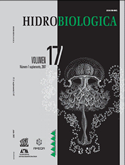Use of aquatic macrophytes in water treatment for the corn and sorghum culture
Keywords:
Macrophytes wetlands, water quality, root growth inhibition.Abstract
Water quality from artificial wetlands on the first growth stages of sorghum (Sorghum bicolor cv. D65) and corn (Zea mays cv. DK 2002) was evaluated. An experiment of three ponds serial system seeded with junco (Scirpus americanus), tule (Typha latifolia) and aquatic liry (Eichhornia crassipes) was conducted. Water was introduced into each pond with a retention time of 15 days. Decreases in all parameters were observed, with exception of the ion nitrate (0.60 to 0.82 mg/l) and the electrical conductivity (34.4 at 66.4 (mS/cm. Diminution in the pH (8.33 to 7.29), as well as the COD (416 to 120 mgO2/l), the ion calcium (6.6 to 0.54 mg/l), the ion chloride (0.011 to 0.002 mg/l), the nitrite (0.234 to 0.040 mg/l), the ammonium (1.451 to 0.0003 mg/l) and the phosphate (10.3 to 2.3 mg/l) were obtained; the Pb and Cd values were below the permissible limit. The total and fecal coliforms decreased in each treatment with a final reduction of 94.17 % and 91.25 %, respectively. Both crops had significant root growth inhibition: sorghum showed a 1.69 cm value in root growth in treated water, 3.0 cm in distilled water and 2.11 cm in the control (untreated water). A 2.78 cm root growth was observed in corn with treated water, 3.05 and 3.35 cm were the values for the distilled water and the control treatments, respectively. The system was efficient in terms of sanitary quality and the reduction of ammonium, calcium, phosphates and COD, but not for salts concentration.Downloads
Downloads
Published
How to Cite
Issue
Section
License
Los autores/as que publiquen en esta revista aceptan las siguientes condiciones:
De acuerdo con la legislación de derechos de autor, HIDROBIOLÓGICA reconoce y respeta el derecho moral de los autores, así como la titularidad del derecho patrimonial, el cual será cedido a la revista para su difusión en acceso abierto.
Publicar en la revista HIDROBIOLÓGICA tiene un costo de recuperación de $500 pesos mexicanos por página en blanco y negro (aproximadamente 29 dólares americanos) y $1000 pesos por página a color (aproximadamente 58 dólares americanos).
Todos los textos publicados por HIDROBIOLÓGICA sin excepción se distribuyen amparados bajo la licencia Creative Commons 4.0Atribución-No Comercial (CC BY-NC 4.0 Internacional), que permite a terceros utilizar lo publicado siempre que mencionen la autoría del trabajo y a la primera publicación en esta revista.
Los autores/as pueden realizar otros acuerdos contractuales independientes y adicionales para la distribución no exclusiva de la versión del artículo publicado en HIDROBIOLÓGICA (por ejemplo incluirlo en un repositorio institucional o publicarlo en un libro) siempre que indiquen claramente que el trabajo se publicó por primera vez en HIDROBIOLÓGICA.
Para todo lo anterior, el o los autor(es) deben remitir el formato de Carta-Cesión de la Propiedad de los Derechos de la primera publicación debidamente requisitado y firmado por el autor(es). Este formato se puede enviar por correo electrónico en archivo pdf al correo: enlacerebvistahidrobiológica@gmail.com; rehb@xanum.uam.mx (Carta-Cesión de Propiedad de Derechos de Autor).
Esta obra está bajo una licencia de Creative Commons Reconocimiento-No Comercial 4.0 Internacional.


